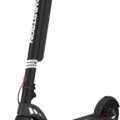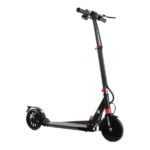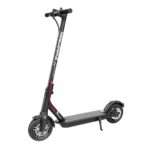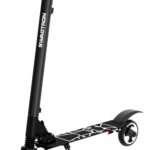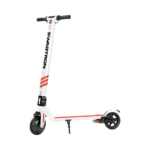- Home
- Scooters
- Electric Scooters
- Swagtron Swagger 8
Swagtron Swagger 8


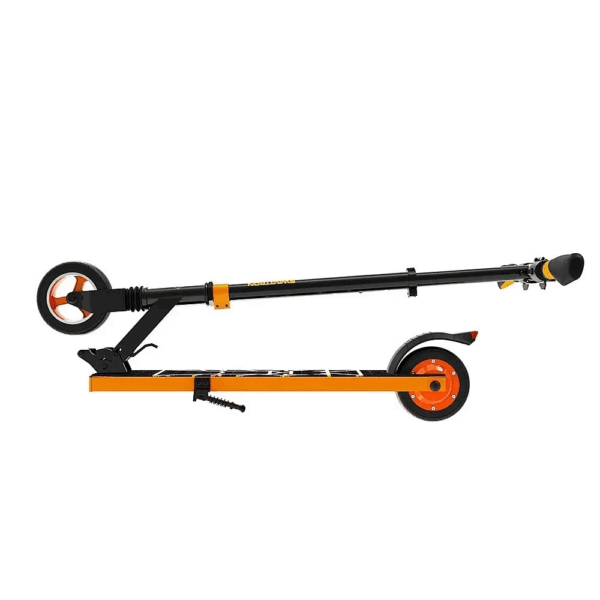
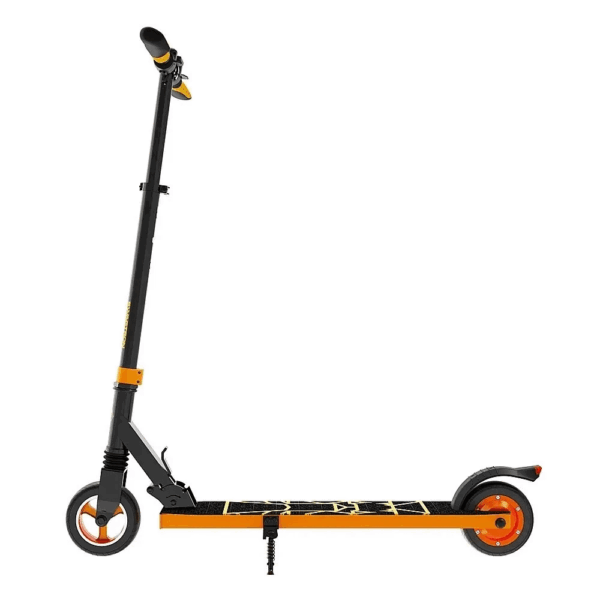
- Battery Range: 15 mph (24.1 km/h)
- Top Speed: 10 miles (16.1 km)
- Motor Power: 200 W motor
- Weight Capacity: 150 lb (68 kg) max rider weight
- Charging Time: About 3 hours
- Scooter Weight: 12.7 lb (5.8 kg) scooter weight
PROS
- Light 12.7 lb (5.8 kg) frame easy for kids to handle
- 15 mph (24.1 km/h) top speed for older kids and teens
- 10-mile (16.1 km) range for short rides
- Front and rear suspension for a smoother ride
- Solid 5.5-inch tires are maintenance-free
- Kick-to-start and IPX4 splash resistance
CONS
- 200 W motor struggles on steep hills
- 150 lb (68 kg) weight limit rules out many adults
- Short range compared with commuter scooters
- Small wheels feel less stable on rough pavement

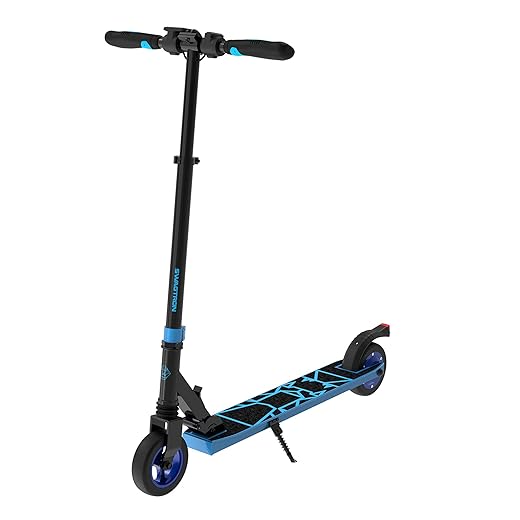
Key Takeaways
- The Swagtron Swagger 8 is a lightweight folding electric scooter designed for kids, teens, and light adults, ideal for short trips and school runs.
- It features a 200-watt rear hub motor, a 24V lithium-ion battery, and a kick-to-start system that provides a smooth ride.
- With solid rubber tires and basic braking options, it delivers safe and stable performance on paved surfaces.
- The range is about 12.4 miles under ideal conditions, making it suitable for short urban commutes.
- Overall, the Swagtron Swagger 8 combines portability, ease of use, and decent performance for younger riders.
Table of contents
- What Is the Swagtron Swagger 8?
- How the Swagtron Swagger 8 Works
- Key Specifications
- Design & Build Quality
- Performance Fundamentals
- Battery, Range & Efficiency
- Ride Quality & Comfort
- Braking & Safety Features
- Portability & Daily Usability
- Swagtron Swagger 8 vs Alternatives
- Who the Swagtron Swagger 8 Is (and Isn’t) For
The Swagtron Swagger 8 is a light folding electric scooter built for kids, teens, and smaller adults. It follows the official specifications for a youth focused ride with a simple layout and low weight. So it fits short school runs, quick trips around the block, and easy last mile rides.
This guide walks through how the Swagtron Swagger 8 works, how it feels on the road, and where it makes sense to choose it over something bigger. The tone stays honest and a bit casual, so you can read it like advice from a friend who knows scooters well.
What Is the Swagtron Swagger 8?
The Swagtron Swagger 8, often shown as the SG-8, is a compact kick-start electric scooter with a 200 watt rear hub motor and a 24 volt lithium-ion battery. It targets riders from older kids through teens and light adults. The rated load tops out at 150 pounds, which equals about 68 kilograms.
The frame uses aluminum alloy tubing. So the scooter stays light but still feels solid enough for daily rides on smooth paths. The stem folds down near the base. Then the whole thing slides under a desk or into a car trunk without drama.
Tires are 5.5 inch solid rubber. You never deal with punctures or pressure checks. A small spring-coil suspension at the front softens cracks and seams. The cockpit stays minimal, with simple grips, a throttle control, and a brake button. There is no app, no complex display, and no long setup.
So the Swagtron Swagger 8 sits in the gap between toy scooters and full adult commuters. It adds power and range to a classic kick scooter shape, yet it keeps size, weight, and speed under control.
How the Swagtron Swagger 8 Works
Think of the Swagger 8 as a kick scooter that gets a strong electric boost once you are rolling. You still push off with your foot. Then the motor takes over and keeps you moving.
Motor and controller
A 200 watt hub motor hides inside the rear wheel shell. It drives the wheel directly. So there is no chain buzz, no belt tension to check, and almost no extra noise. Power runs from the battery pack in the deck, through a controller, and into that motor.
The controller reads your throttle input and your current speed. Then it decides how much current to send to the motor. It also limits speed in each riding mode. Low modes cap power for new riders. Higher modes open up the full range once the rider feels ready.
Kick-to-start and throttle behavior
The Swagtron Swagger 8 uses a kick-to-start system. You push off like you would on a normal scooter. Once you roll past a slow walking pace, the controller lets the motor wake up. So the scooter never jerks from a dead stop when someone bumps the throttle by mistake.
The throttle sits on the handle. You press and hold it to keep speed. Release it and the scooter coasts. After you hold a steady pace for a short stretch, cruise control can lock that speed. Then you rest your thumb and just steer until you need to slow down.
This setup feels natural after a few rides. At first it may feel odd to kick once more than you expect. Then you feel the motor pick up and you stop thinking about the timing.
Battery and power flow
Inside the deck sits a 24 V, 4.0 Ah lithium-ion battery pack. That equals roughly 96 watt-hours of stored energy. The pack feeds the controller, which then feeds the motor. All the wiring runs through the body of the scooter.
You charge the scooter with a small wall charger that plugs into a port on the side of the deck. A full charge from low battery usually takes around three hours. There is no removable battery here. So you park the whole scooter near an outlet when you charge.
Brakes and safety cutoffs
The Swagtron Swagger 8 uses a three part braking system.
- A handle mounted electronic brake for smooth slowing.
- A rear fender foot brake for stronger stops.
- An Autoguard motor cutoff that cuts power any time you brake.
So you tap the electronic brake for mild speed control. You press the rear fender when you need a firm stop. And you never fight the motor during braking, since Autoguard shuts it down right away.
Key Specifications
Here is a clean table of the main technical details for the Swagtron Swagger 8. These values follow the official data and keep both imperial and metric units.
| Category | Details |
|---|---|
| General | Brand: Swagtron • Model: Swagger 8 / SG-8 • Type: Folding kick-start electric scooter for kids, teens, and light adults |
| Performance & Power | Motor: 200 W rear hub motor • Top speed: up to 15 mph (24 km/h) on level ground with a light rider • Rated hill grade: up to about 10% on short climbs • Drive layout: rear wheel hub |
| Battery, Charging & Electrical | Battery: 24 V 4.0 Ah lithium-ion (about 96 Wh) • Rated range: up to 12.4 miles (20 km) under light, ideal use • Typical charge time: roughly 3 hours from low battery • System: kick-to-start with basic speed modes |
| Build & Dimensions | Frame: aluminum alloy • Scooter weight: about 17.5 lb (7.9 kg) • Max rider weight: 150 lb (68 kg) • Unfolded size: ~36.4 x 16.9 x 40.2 in (92.5 x 43 x 102 cm) • Folded size: ~33.5 x 16.9 x 11.4 in (85 x 43 x 29 cm) |
| Safety & Control | Brakes: electronic handle brake, rear foot brake, Autoguard motor cutoff • Water protection: light splash resistance roughly in the IPX4 range • Electrical safety: UL 2272 style compliant system in most listings |
| Features & Extras | Cruise control at steady speed • Kick-to-start function • Adjustable handlebar height • Front spring-coil suspension fork • 5.5 in solid rubber tires • Multiple riding modes |
| Warranty & Compliance | Typical listed warranty: limited 90 days from many sellers • Coverage varies by region and store • Built to common small electric rideable standards |
This table gives a quick view of where the Swagtron Swagger 8 sits in power, size, and rider limits. So you can compare it with other scooters without digging through marketing pages.
Design & Build Quality
The design of the Swagtron Swagger 8 feels familiar if you have seen a kick scooter before. The stem is straight and slim. The deck is low and narrow. The wheels look small compared with big adult commuter scooters. So it never looks bulky or intimidating.
The frame uses aluminum alloy tubes with a simple folding joint near the base of the stem. Welds and hardware look basic but clean for this class. Paint and graphics tend to be bright and a bit playful, which fits younger riders. So the scooter looks more like gear for school and parks than a heavy office commuter.
The deck has grip tape along the top surface. The grip runs close to the full length. One foot fits at the front at a slight angle. The other sits behind it. Shorter riders can stand with feet close together for easy balance. The deck height is low, which helps with both stability and comfort during kicks.
The stem height adjusts through a clamp and pin system. You loosen the clamp, slide the bar up or down, then lock it again. Then the scooter grows with the rider across a few years. This matters for families who want to pass it from one child to another or share it between siblings.
On the handlebar you find soft grips, a small throttle control, and a brake button. Some versions add basic LEDs for battery level or mode, but nothing too fancy. There is no big color screen here, and that is fine. So riders spend more time watching the road and less time staring at numbers.
The folding system uses a lever at the base of the stem. Pull, fold, and then clip. It is not the most advanced hinge in the scooter world, yet it does the job for a 17.5 pound scooter. As long as you keep bolts and latches snug, the Swagger 8 feels sturdy enough for its target use.
Performance Fundamentals
The Swagtron Swagger 8 does not chase high speed thrills. It focuses on steady, predictable performance for younger riders. So you feel calm, not nervous, once you get moving.
From a kick and a press of the throttle, the 200 watt motor brings you up to speed in a smooth arc. It does not snap your head back. For most kids and teens, that is a good thing. It gives time to adjust to the feel of the scooter and the balance over the deck.
Top speed sits around 15 mph on flat ground with a lighter rider. At that pace, the scooter feels lively but not wild. For riders close to the 150 pound limit, top speed drops a bit. So the scooter feels more like a strong assist than a rocket. That lines up with its design goal.
At a cruise around 10 to 12 mph, the Swagger 8 feels very natural. The small solid tires roll smoothly on decent asphalt and many sidewalks. The short wheelbase keeps the turning circle tight. So kids can swing around corners in parks and on paths without leaning too far.
Hill behavior matches the modest motor size. The scooter moves up short slopes in the 7 to 10 percent range, especially for lighter riders. On long steep hills, speed falls off. Then riders often add a few kicks to help. So it suits mild rolling hills much more than long steep climbs.
Speed modes help fine tune the experience. Low modes cap speed, which helps when kids ride in tight areas or learn the basics. Higher modes open the full range for open segments. Parents often start kids on lower modes. Then they bump them up once they see solid balance and brake use.
Battery, Range & Efficiency
The battery pack inside the Swagtron Swagger 8 is not huge, yet it fits the scooter well. It holds 24 V at 4.0 Ah, which gives roughly 96 watt-hours. So it favors short urban trips and light riders instead of long distance duty.
The rated range is up to 12.4 miles, or about 20 kilometers. That number assumes a light rider, warm day, flat route, and gentle riding in a lower speed mode. Real life looks different. So it is smarter to treat that number as a best case.
In daily use, many riders land in the 6 to 10 mile band, or about 10 to 16 kilometers. Light kids on flat paths with frequent coasting sit near the top of that range. Heavier riders, lots of hills, cold mornings, and full speed sprints bring range closer to the lower side. That pattern matches how small batteries behave in most light scooters.
The kick-to-start design helps with efficiency. Each push gets the scooter moving, then the motor steps in. So the motor does not eat a big surge of power from every stop. Over a full ride with many lights and crossings, that habit stretches range more than many riders expect.
Charging stays simple. Plug the included charger into the deck port and a wall outlet. A typical full charge from low battery takes around three hours. So you hang the scooter on charge after school or work. Then it is ready for the next day.
For better long term health, store the scooter indoors and out of direct sun. Try not to leave the pack totally empty for weeks. Give it a brief top-up now and then during long breaks. These small habits help the pack keep decent range over many seasons.
Ride Quality & Comfort
Ride comfort on the Swagtron Swagger 8 is a mix of win and compromise, which is normal for a light scooter. The good part is the smooth feel on clean ground. The tougher part is vibration on rough patches.
The 5.5 inch solid rubber tires roll fast and never need air. So you stay free from flats and pressure checks. On fresh asphalt, painted school yards, or indoor surfaces, the scooter glides with very little fuss. There is a soft whir from the motor and not much else.
As the surface gets rough, the solid tires start to send more feedback into the frame. Cracks, patched spots, and broken sidewalks all show up through your feet. The front spring-coil shock helps. It compresses over some of the bumps and takes the sting out of sharp edges. It will not erase deep potholes, yet it makes normal city seams easier to live with.
The low deck height helps comfort more than many people think. With a low deck, your knees bend less when you kick. You also sit lower relative to the axles. So the scooter feels more planted. This reduces that top-heavy wobble feeling some scooters have at speed.
Handlebar comfort is solid for the target group. The grips have enough padding for short to medium rides. The adjustable height lets you set the bar just above the hips for most kids and teens. When arms bend slightly, you get better control and less fatigue.
There is some flex in the stem, especially when taller riders lean hard into a turn or hit a bump. That is normal in light folding models. As long as the clamp stays tight and you do not treat the scooter like a stunt deck, this flex feels more like a gentle give than a problem.
Noise stays low across all of this. So early morning rides do not wake neighbors. You mostly hear the tires and some hardware rattle on rough ground.
Braking & Safety Features
Braking is one of the most important parts of any scooter, and the Swagtron Swagger 8 does well for its size and speed class.
The electronic brake lives on the handle. Press it and you feel the motor pull back and slow the wheel. The feel is smooth and mild. So it works best for control on gentle slopes, small speed trims, or cruising paths where you adjust pace often.
The rear foot brake is more direct. Step down on the rear fender and it presses on the wheel. At low and medium speeds on dry ground, this gives strong stopping force. Kids who grew up on kick scooters know this move already, which helps the learning curve.
Autoguard ties it together. When either brake comes on, Autoguard cuts motor power right away. So you never have a moment where the motor tries to push and the brake tries to slow. That clear rule under the hood leads to more stable stops and fewer surprises.
Safety extras are basic. Many listings show reflectors and sometimes small lights, but not a bright built-in headlight. So riders who plan to roll at dusk or in the dark should add a clip-on front light and a rear light or reflective band. Helmets stay a smart idea for all ages, even on slow scooters.
Water resistance sits at light splash levels. Short runs on damp ground are fine. Deep puddles, heavy rain, or long storage outdoors raise the risk of damage. Local rules for electric scooters vary by city. So it is smart to check age rules, sidewalk rules, and bike path rules before a first long ride.
Portability & Daily Usability
Portability is where the Swagtron Swagger 8 really shines. The scooter weighs about 17.5 pounds, or 7.9 kilograms. So most teens and many older kids can carry it with one hand. Adults can grab it and climb stairs without a second thought.
The folded size is small. Once you fold the stem, the scooter sits around 33.5 inches long, 16.9 inches wide, and 11.4 inches tall. In metric that is close to 85 x 43 x 29 centimeters. So it slides under a desk, behind a door, or into a trunk without feeling in the way.
Daily use stays simple. You unfold it, lock the latch, set your speed mode, and ride. At the end of the trip, you fold it again and charge if needed. Solid tires remove a huge headache here, since you never rush to fix a flat before school.
Kick-to-start helps in crowded spaces. The scooter will not leap away from you from a standstill. So kids who fidget with controls in parking lots have a little safety net. Parents like that detail. It feels small, yet in real life it matters.
For storage, an indoor corner or hallway is ideal. The battery and electronics stay dry and warmer in winter. For security, a simple U-lock or cable lock through the frame and a fixed rail works for short stops. Many people just bring the scooter inside at school, the office, or home, since it is light enough to carry everywhere.
Swagtron Swagger 8 vs Alternatives
The Swagtron Swagger 8 sits in a pretty crowded space. There are many small scooters out there now. So it helps to see what makes this one stand out.
Compared with full adult commuters, the Swagger 8 is lighter and less powerful. Bigger models pack motors in the 250 to 350 watt range, often with larger batteries and taller frames. They haul adult riders at higher speeds and handle longer commutes. In return, they weigh a lot more and take more storage space. A model like the Swagtron Swagger 7 leans more in that commuter direction, with a stronger setup for grown riders.
Compared with toy grade scooters from big box stores, the Swagger 8 feels more grown up. It brings cruise control, adjustable bars, front suspension, and a well tuned motor. So it handles real short commutes instead of just driveway loops.
Compared with mid level youth scooters, the Swagger 8 often wins on weight and simplicity. Some rivals add bigger displays and apps. Those can be fun. Then they add more to break and more to charge. Swagtron takes the other path here. It keeps the cockpit clean and focuses on ride and fold.
If you picture a rider who needs long range, full adult weight support, and high hill power, the Swagger 8 will feel like a half step. That rider fits better on a heavier scooter with stronger parts. If you picture a kid or teen who wants a light ride for school and parks, the Swagger 8 suddenly looks like the right tool.
Who the Swagtron Swagger 8 Is (and Isn’t) For
Ideal riders and uses
The Swagtron Swagger 8 fits a clear group of riders and routes. It makes the most sense for:
- Kids and teens in the 44 to 150 pound range.
- Students who link a bus or train ride with a short scooter leg.
- Light adults who want something tiny for quick hops.
- Families who want one scooter to share among siblings.
It works best when:
- Routes are short, often 1 to 4 miles each way.
- Paths are mostly smooth, with only mild rough spots.
- Hills are present but not long or extremely steep.
The scooter rewards smooth riders who enjoy coasting and gentle curves. Parents who want clear limits on speed and size often feel good about its numbers.
Riders who should look elsewhere
The Swagger 8 does not suit every case. It falls short when:
- The main rider weighs more than 150 pounds.
- Daily trips often run past 10 to 12 miles total.
- The route includes many rough brick streets or deep potholes.
- The rider wants sharp acceleration and high top speed.
In those cases, it makes more sense to step up to a heavier commuter scooter with more motor power and bigger air filled tires. A model like the Swagtron 5 Elite leans more toward that city rider role, with a stronger build aimed at adults.
The Swagger 8 also will not impress riders who crave big bright displays, complex apps, and full lighting kits. Its strength sits in a different place. It wins on size, friendly behavior, and low upkeep.
Trade-offs in plain terms
Every scooter lives in a trade-off space, and this one is no different. The Swagtron Swagger 8 offers:
- Low weight and fast folding.
- A quiet 200 watt rear hub motor.
- A small battery that charges quickly.
- Solid tires that never go flat.
In return it gives up:
- Big hill climbing strength.
- Long true range for heavy riders.
- Deep suspension comfort.
- Bright built-in lights and advanced displays.
For many kids, teens, and light adults, that trade feels fair. It gives them a scooter that is easy to carry, easy to store, and easy to ride. The official specifications line up well with that use case and with real world feedback from daily school and neighborhood rides.
Specifications
General
| Model The Model specifies the exact version or name of the scooter. It helps identify its unique design, features, and specifications within the manufacturer’s product line. Knowing the model makes it easier to compare options, find compatible accessories, or look up support information. | Swagger 8 |
| Brand The Brand identifies the manufacturer or company that designs and produces the scooter. A trusted brand is a sign of quality, reliability, and good customer support. Well-known brands often have higher standards for safety, performance, and after-sales service, giving you more confidence in your purchase. | Swagtron |
| Release Date The Release Date indicates when the scooter model was officially launched on the market. This helps you know how current the design, technology, and features are. A newer release date often means updated components, improved performance, and the latest safety or smart features. | 18 November 2025 |
| Recommended Age Recommended Age indicates the minimum age range that the scooter is designed for, based on safety, size, and ease of use. Following the recommended age helps ensure that riders can handle the scooter’s speed, weight, and controls comfortably and safely. Always check local laws and use protective gear, especially for younger riders. | 14+ |
Performance & Power
| Motor Power (Wattage) What it means: The motor power, measured in watts (W), shows how strong the scooter’s electric motor is. Why it matters: Higher wattage usually means better acceleration, more torque, and improved performance on hills or rough terrain. For example, a 250W motor is good for flat city roads and light riders, while a 500W or 1000W motor provides more power for faster speeds or climbing steep inclines. | 200 W front hub motor (24 V) |
| Top Speed The Top Speed indicates the maximum speed that the scooter can reach under optimal conditions. It’s usually measured on level ground with a fully charged battery and an average rider weight. A higher top speed allows you to travel longer distances faster, but always ensure you ride within legal speed limits and your personal comfort zone for safety. | 15 mph (24.1 km/h) |
| Battery Capacity Battery Capacity refers to the total amount of energy the scooter’s battery can store, usually measured in ampere-hours (Ah) or watt-hours (Wh). A higher battery capacity means you can ride longer distances on a single charge, reducing the need for frequent recharging. Keep in mind that actual range can vary depending on rider weight, terrain, speed, and weather conditions. | 24 V 4.0 Ah (100.8 Wh) lithium-ion battery |
| Estimated Range per Charge The Estimated Range per Charge indicates the average distance the scooter can travel on a single full battery charge. This range is calculated under optimal conditions, such as flat terrain, moderate speed, and average rider weight. Real-world range may vary depending on riding style, terrain, weather, and load. A longer range means fewer recharges and greater freedom for longer trips. | 10 miles (16.1 km) |
| Hill Climb Ability Hill Climb Ability describes the maximum incline or slope that the scooter can handle while maintaining stable performance. It’s typically expressed as a percentage or in degrees. A higher hill climb rating means the scooter can tackle steeper hills without losing too much speed or power. Actual climbing performance may vary based on rider weight, battery charge, and terrain conditions. | Suitable for gentle inclines. hill rating not specified |
| Drive System The Drive System refers to how power from the motor is delivered to the wheels. Electric scooters typically use either a hub motor (directly integrated into the wheel) or a chain/belt drive system. A high-quality drive system ensures smooth acceleration, efficient power transfer, and low maintenance. The choice of drive system affects performance, noise level, and overall ride experience. | Front-wheel drive (FWD) |
Charging & Electrical
| Charging Time Charging Time indicates how long it takes to fully recharge the scooter’s battery from empty to 100% using the standard charger provided. Faster charging means less downtime and more time on the road. Actual charging time may vary slightly depending on battery capacity, charger output, and environmental conditions. | Approx. 3 hours |
| Battery Type Battery Type refers to the specific technology used in the scooter’s battery, which affects performance, lifespan, weight, and charging time. Most modern electric scooters use high-quality lithium-ion (Li-ion) batteries because they offer a good balance of energy density, durability, and low maintenance. A reliable battery type ensures consistent power delivery and longer riding ranges. | 24 V lithium-ion battery with protection circuitry |
| Removable Battery A Removable Battery means the battery pack can be easily detached from the scooter for convenient charging and replacement. This feature allows you to charge the battery separately, swap it with a spare for extended range, or securely store it indoors in extreme weather. Removable batteries add flexibility and make it easier to keep your scooter powered up wherever you are. | No. internal non-removable pack |
| Regenerative Braking Regenerative Braking is an energy-saving feature that converts some of the energy normally lost during braking back into battery power. When you slow down or brake, the motor works in reverse to generate electricity, which helps extend the scooter’s range and improves overall efficiency. This system also reduces wear on traditional brake components, leading to lower maintenance over time. | Yes. front electronic brake with energy recovery |
| Lighting Lighting refers to the built-in front and rear lights that enhance visibility and safety when riding in low-light conditions or at night. Good lighting helps you see the road ahead and ensures that other road users can see you. Many scooters include LED headlights, taillights, and sometimes brake lights or side reflectors for added safety and compliance with local traffic regulations. | LED headlight and rear reflectors |
Build & Dimensions
| Scooter Weight Scooter Weight refers to the total weight of the scooter when fully assembled, including the battery. This affects how easy it is to carry, lift, and store the scooter when not in use. A lighter scooter is more portable and convenient for commuting, especially if you need to carry it upstairs or onto public transport. Keep in mind that a sturdy frame and quality components may add to the weight but also contribute to better durability and ride stability. | 12.7 lb (5.8 kg) |
| Maximum Rider Weight Maximum Rider Weight indicates the highest rider weight that the scooter is designed to safely support while maintaining optimal performance and stability. Staying within this limit helps ensure reliable acceleration, braking, and climbing ability, and it protects the frame, suspension, and motor from excessive strain. Exceeding the recommended limit may reduce performance and increase wear on components. | 150 lb (68 kg) |
| Deck Size Deck Size refers to the dimensions of the scooter’s standing platform. A wider and longer deck provides more foot space, allowing you to stand comfortably and adjust your stance while riding. A well-sized deck improves balance and stability, especially on longer rides or at higher speeds. Compact decks, on the other hand, help keep the scooter lightweight and portable. | Youth-sized frame for kids and teens |
| Handlebar Height Handlebar Height refers to the distance from the deck to the handlebars, which affects your riding posture and comfort. An appropriate handlebar height helps you maintain good balance, reduces strain on your back and arms, and makes steering more comfortable. Some scooters have adjustable handlebars to fit riders of different heights, while others have a fixed height for a streamlined design. | Adjustable handlebar height |
| Folding Mechanism The Folding Mechanism describes how easily and securely the scooter can be folded for carrying and storage. A well-designed folding system lets you quickly collapse the scooter into a compact size, making it convenient to transport on public transit, store under a desk, or fit into a car trunk. Look for sturdy latches and safety locks to ensure the scooter stays firmly in place when folded or unfolded. | Folding stem with latch |
| Dimensions Folded Dimensions indicate the size of the scooter when it’s fully folded. This measurement shows how much space the scooter will take up when stored or carried, making it easier to check if it will fit in your car trunk, under a desk, or in a closet. Compact folded dimensions are ideal for commuters who need to bring their scooter on public transport or store it in tight spaces. | Unfolded dimensions 35.4 x 15.4 x 41.5 in (approx.). Folded dimensions Not specified |
| Material Material refers to the primary construction materials used for the scooter’s frame and key components. High-quality materials like aircraft-grade aluminum, reinforced steel, or durable composites provide strength, stability, and a lighter overall weight. A sturdy material ensures the scooter can handle daily wear and tear while maintaining safety and performance. | Aluminum frame |
Safety & Control
| Brake Type(s) Brake Type(s) describe the braking systems the scooter uses to help you slow down or stop safely. Common brake types include mechanical brakes (like drum or disc brakes), electronic brakes, and foot brakes. Many scooters combine multiple braking systems for added safety and shorter stopping distances. The type and quality of brakes affect your control, especially when riding at higher speeds or on slopes. | Front electronic brake plus rear friction/heel brake |
| Suspension Suspension refers to the system that absorbs shocks and vibrations while riding, providing a smoother and more comfortable ride over uneven or rough surfaces. Scooters may have front suspension, rear suspension, or dual suspension for better shock absorption and stability. Good suspension helps reduce rider fatigue and improves control, especially when riding on bumpy roads or off-road paths. | Front and rear spring suspension |
| Tire Type Tire Type refers to the kind of tires the scooter uses, which directly affects ride comfort, traction, and maintenance. Common types include solid (airless) tires, pneumatic (air-filled) tires, or hybrid options. Pneumatic tires offer better shock absorption and a smoother ride on rough surfaces, while solid tires are puncture-proof and require less upkeep. The right tire type helps ensure safe handling and a comfortable ride in different conditions. | 5.5-inch solid rubber tires |
| Tire Size Tire Size indicates the diameter and width of the scooter’s tires, which affect ride comfort, stability, and how well the scooter handles different terrains. Larger tires generally offer better shock absorption and a smoother ride over bumps and rough surfaces, while smaller tires keep the scooter lighter and more portable. Choosing the right tire size helps ensure a balance between agility and comfort. | 5.5-inch wheels |
| Kickstand The Kickstand is a built-in stand that allows you to park your scooter upright when it’s not in use. A sturdy kickstand keeps the scooter stable and prevents it from tipping over, protecting it from scratches and damage. It also makes storing and accessing your scooter more convenient, whether you’re at home, work, or on the go. | Side kickstand |
| Water Resistance Rating Water Resistance Rating indicates how well the scooter is protected against water and moisture, usually shown as an IP (Ingress Protection) rating. This rating helps you understand whether the scooter can handle light rain, splashes, or wet roads without damage. While most scooters are not fully waterproof, a good water resistance rating adds peace of mind when riding in changing weather conditions. Always avoid deep puddles or submerging the scooter to protect its electrical components. | IPX4 |
Features & Extras
| Display/Console The Display (or Console) shows important real-time information about your ride, helping you monitor your scooter’s status at a glance. Typical displays show speed, battery level, distance traveled, and riding mode. Some models also include additional features like Bluetooth connectivity, app integration, or backlighting for better visibility at night. A clear and easy-to-read display enhances safety and convenience on every trip. | Basic LCD display for speed and battery |
| Ride Modes Ride Modes refer to the different speed and power settings you can choose to match your riding style or road conditions. Common modes include eco for maximum range and energy efficiency, standard for everyday balance, and sport or turbo for higher speed and stronger acceleration. Switching between ride modes allows you to customize performance, conserve battery, and ride safely in various environments. | Multiple speed modes suited to young riders |
| Smart App Connectivity Smart App Connectivity lets you pair your scooter with a dedicated mobile app via Bluetooth. Using the app, you can monitor real-time ride stats like speed, battery level, and range, adjust settings such as ride modes or cruise control, lock the scooter for added security, and sometimes receive firmware updates. This feature adds convenience and allows you to personalize your riding experience right from your smartphone. | No companion app |
| Anti-Theft System The Anti-Theft System helps protect your scooter from unauthorized use or theft. This feature can include built-in alarms, electronic motor locks, GPS tracking, or remote locking through a mobile app. A good anti-theft system provides peace of mind when parking your scooter in public spaces, adding an extra layer of security to safeguard your investment. | Bell and reflectors add passive safety |
| Cruise Control Cruise Control allows you to maintain a steady speed without continuously holding the throttle. This feature makes longer rides more comfortable by reducing hand fatigue and providing a smoother, more relaxed riding experience — especially on flat, open roads or bike lanes. For safety, cruise control can usually be easily activated or deactivated while riding. | Cruise control mode available |
| Accessories Included Accessories Included lists the additional items that come with the scooter to enhance your riding experience and convenience. Common accessories may include a charger, kickstand, bell, lights, phone holder, or carrying strap. These extras add value by making your scooter safer, easier to use, and ready to ride straight out of the box. | Includes scooter, 24 V charger and manual |
Warranty & Compliance
| Warranty Period The Warranty Period indicates how long the manufacturer guarantees the scooter against defects in materials and workmanship under normal use. A good warranty provides peace of mind, showing the brand’s confidence in its product quality. Always check what parts are covered, such as the frame, battery, and motor, and follow the maintenance guidelines to keep your warranty valid. | 12-month limited warranty. region-dependent |
Price Comparison






